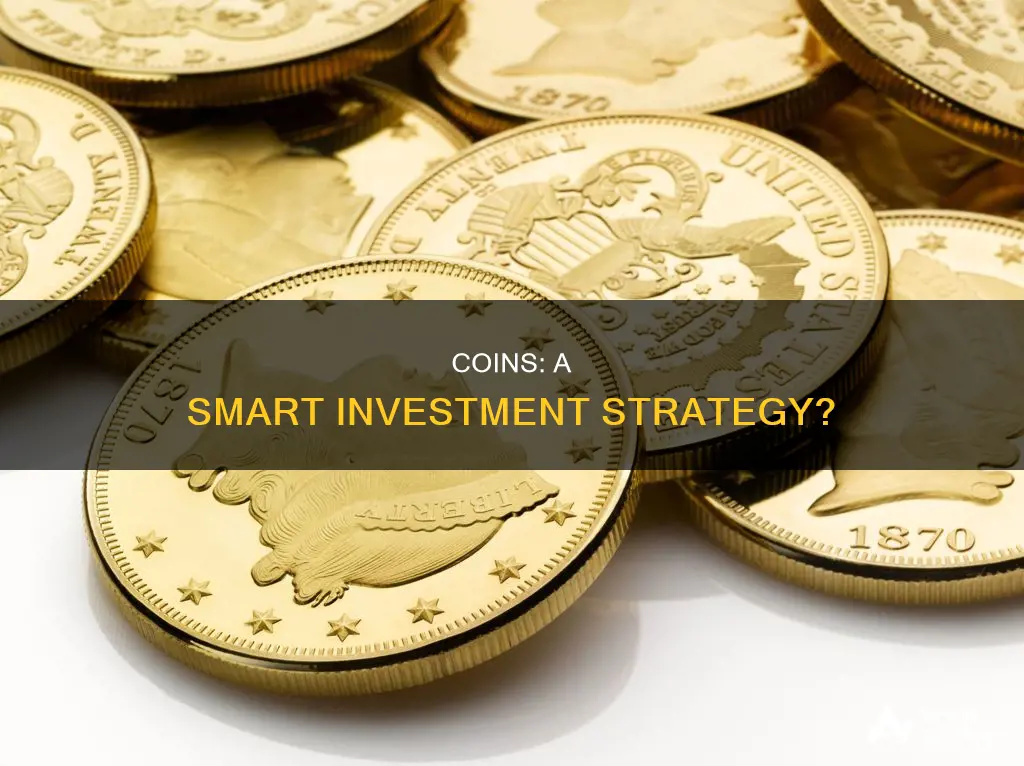
Investing in coins can be a profitable venture, but it is important to approach the market with caution and do thorough research. Coins derive their value from two main sources: the physical metal they contain, and their collector or numismatic value. The former, also known as bullion value, is determined by the amount of metal in a coin and its spot price. The latter, which applies mostly to antique and rare coins, is influenced by factors such as scarcity and condition. While investing in rare coins can be lucrative, it is challenging to predict the collector market. As such, investing in modern bullion coins, such as Canadian Maple Leaf silver coins or American Gold Eagles, may be a safer option. These coins offer both bullion and collector value. Additionally, it is crucial to purchase coins from reputable dealers and avoid falling prey to misleading advertisements or high-pressure sales tactics.
| Characteristics | Values |
|---|---|
| Profitability | Coin collecting can be a profitable venture when done right. |
| Numismatic value | The value of a coin depends on buyer sentiment. The fewer examples of a coin minted, the higher its collector value. |
| Bullion value | The value of a coin is derived from the physical metal it contains. |
| Collectible coins | Collectible coins are rarely a good investment. |
| TV shopping coins | Coins sold on TV shopping networks are usually priced several times higher than their actual value. |
| National Collector's Mint | The United States Mint has issued warnings about this company's misleading advertisements. |
| Franklin Mint | Coins from the Franklin Mint usually do not have any premium after-market value. |
| Gold | Gold is a prudent way to diversify portfolios. |
| Cryptocurrency | Cryptocurrency is a good investment if you want direct exposure to the demand for digital currency. |
What You'll Learn

Coins as a store of value
Coins can be a good investment and store of value, depending on the type of coin and the market conditions. Here are some factors to consider when thinking about coins as a store of value:
Bullion Value
The bullion value of a coin is determined by the physical metal it contains, usually precious metals like gold or silver. The value can be calculated by multiplying the number of ounces of metal in the coin by the spot price of that metal at any given time. Coins made of precious metals can be a good store of value as these metals tend to retain their value over time. Gold, for instance, has been a dominant store of value for thousands of years due to its durability and scarcity.
Numismatic or Collector's Value
Antique and rare coins have a collector or numismatic value that is harder to determine than bullion value. This value depends on buyer sentiment and factors such as the rarity of the coin, minting errors, and the condition of the coin. The fewer examples of a particular coin were minted, the higher its collector value is likely to be. Additionally, coins that are in uncirculated or near-perfect condition tend to fetch higher prices from buyers who value their numismatic appeal.
Coin Collecting as a Hobby
Coin collecting can be a fun and exciting hobby, allowing individuals to engage with history, art, and the challenge of finding rare coins. While it can also be a profitable venture, it is important to remember that, as with any investment, there are risks involved. Recognizing undervalued assets, understanding the precious metals market, and knowing how to interpret market movements can help optimize the timing of purchases and increase the potential for profit.
Cryptocurrency Coins
Cryptocurrency coins, such as Bitcoin and Ethereum, are decentralized and secure digital currencies based on blockchain technology. They offer new investment opportunities but come with higher risks than traditional investments. Cryptocurrency exchanges are vulnerable to hacking and other criminal activities, and there is no guarantee that a crypto project will succeed or that regulators will not crack down on the industry. However, cryptocurrencies have gained traction and are increasingly being adopted by individuals and companies, indicating a maturing industry.
In conclusion, coins can be a store of value and a good investment, depending on various factors such as the type of coin, market conditions, and the individual's knowledge and risk tolerance. It is essential to do thorough research and understand the potential risks and rewards before investing in coins.
Copper Coins: Worthy Investment or Worthless?
You may want to see also

Bullion value
The bullion value of a coin is derived from the physical metal the coin contains. Many collectible coins are made from precious metals such as gold or silver, giving them intrinsic value as stores of these metals. The bullion value of a coin can be calculated by multiplying the number of ounces of metal in a coin by the spot price per ounce of that metal at any given time.
When investing in coins, it is generally recommended to focus on bullion value, especially when starting a coin collection. Modern bullion coins, such as Canadian Maple Leaf silver coins and American Gold Eagles, contain high-grade gold or silver, making them excellent precious metal investments. Older coins can also be good stores of bullion value, such as American quarters and dimes minted before 1965, which contain 90% silver.
Canadian Mint coins, for example, are respected worldwide for their design and quality of engraving. They are available in gold, silver, and platinum, with most gold coins being 99.999% pure gold. The bullion value of Canadian Mint coins is further enhanced by their aesthetic appeal, making them a desirable investment option.
Overall, the bullion value of a coin is a crucial factor in determining its investment potential. Coins with higher bullion value, particularly those made from precious metals, can be a profitable addition to an investment portfolio.
Elon Musk's Dogecoin Investment: How Much?
You may want to see also

Numismatic value
Investing in coins can be a profitable venture, but it is a complex topic with many factors to consider. One of the key distinctions in the coin market is between bullion and numismatic coins. Numismatic coins, also known as collectible coins, are valued based on intangible factors such as age, rarity, year of issue, design, and the mint at which they were struck. Their value is largely subjective and dependent on buyer sentiment.
- Rarity: The rarer a coin is, the higher its numismatic value. Coins with low minting numbers or those that are hard to find tend to be more valuable due to their scarcity.
- Condition: The condition of a coin plays a significant role in its numismatic value. Buyers who value coins for their aesthetic appeal tend to pay higher prices for coins that are in near-perfect or uncirculated condition compared to those that show signs of wear and tear.
- Historical Significance: Numismatic coins often carry historical value, making them attractive to collectors. Coins from specific periods or with historical significance can demand higher prices.
- Demand: The demand for a particular coin or series can drive up its price. If a coin becomes popular among collectors, its value can increase significantly. However, demand can also fluctuate, leading to potential losses if the popularity of a coin wanes.
- Grading: The grade or quality of a coin is an important factor in determining its numismatic value. Reputable grading services, such as PCGS or NGC, evaluate and certify coins, which can impact their value. Higher-graded coins tend to be more desirable and fetch higher prices.
- Mint Marks: Mint marks indicate where a coin was produced, and certain mints are more coveted by collectors than others. For example, the CC mint mark is highly sought after by collectors.
- Long-term Investment: Numismatic coins are typically a long-term investment strategy. Their value can increase over time as they become rarer or gain historical significance. However, it is important to be aware of potential fluctuations in the market and the subjective nature of coin values.
- Specialized Market: The numismatic market is relatively small and specialized compared to the bullion market. This can make it challenging to find buyers or sellers, and the prices of numismatic coins can vary widely.
- Research and Expertise: Investing in numismatic coins requires a significant amount of research and expertise. Collectors should study the market, consult reputable sources, and become familiar with grading terms and standards to make informed decisions.
- Fraud and Scams: The numismatic market is susceptible to fraud and deceptive marketing. It is important to be cautious when purchasing numismatic coins and to deal only with reputable dealers and certified coins to minimize the risk of scams or counterfeit coins.
Litecoin or Bitcoin Cash: Which Crypto is the Better Investment?
You may want to see also

Collectible coins
Firstly, it is important to distinguish between bullion coins and numismatic coins. Bullion coins are typically bought by investors for their intrinsic value, as they are made from precious metals such as gold or silver. On the other hand, numismatic coins are usually bought by collectors for their rarity, historical value, and uniqueness. These coins derive their value from both their bullion content and their collector or numismatic value.
When investing in collectible coins, it is crucial to focus on coins that are rare and in high demand. The rarer the coin, the higher its collector value due to limited supply. Additionally, the condition of the coin plays a significant role in its value, with uncirculated or mint-condition coins often attracting higher prices.
It is also important to be cautious when purchasing collectible coins. Avoid coins that are simply plated with a thin layer of gold or silver, as these have little intrinsic value. Instead, opt for certified coins that have been inspected and graded by a recognised organisation.
Investing in collectible coins can be a long-term strategy, as it may take time to see significant profits. The market for collectible coins can be volatile, with prices fluctuating based on supply and demand. However, collectible coins can provide diversification to an investment portfolio, especially during uncertain market conditions.
Overall, investing in collectible coins requires knowledge, patience, and an understanding of the market. It can be a rewarding venture, both financially and as a hobby, but it is important to do your due diligence before making any investments.
Smart Ways to Invest Small in Bitcoin
You may want to see also

Commemorative coins
The United States Mint has been issuing commemorative coins since 1892, telling the story of America through these coins. Modern commemoratives, many of which are silver and gold, began to be issued in 1982. One of the most popular modern commemorative coins was the 1986 Statue of Liberty Half Dollar, which celebrated the 100th anniversary of the Statue of Liberty and America's history of immigration.
When it comes to investing in coins, there are a few things to consider. Firstly, the value of a coin comes from its bullion value and its collector or numismatic value. The bullion value is based on the physical metal contained in the coin, such as gold or silver. The collector value, on the other hand, depends on factors like rarity, condition, and buyer sentiment. Investing in modern bullion coins, such as Canadian Maple Leaf silver coins or American Gold Eagles, can be a great way to get started as they contain high-grade gold or silver and are also attractive coins.
Overall, investing in commemorative coins can be a good idea, especially if you are interested in American history and culture. These coins often have low mintages and can increase in value over time, making them a potential source of profit. However, it is important to do your research and understand the risks involved in any type of investing, including investing in coins.
Small Bitcoin Investments: Are They Worth Your Money?
You may want to see also
Frequently asked questions
It depends on the type of coin. Coins can be a profitable investment when done right. Coins derive their value from their bullion value (the physical metal contained in the coin) and their collector or numismatic value. Coins made from precious metals such as gold or silver are good stores of value. The higher the bullion value, the higher the coin's value. Numismatic value depends on buyer sentiment and the rarity of the coin.
Coins can be a risky investment due to price volatility, storage and insurance costs, and the potential for political events to affect their value. Additionally, some coins may be overpriced or undervalued, leading to losses for investors.
Investing in coins can provide diversification to a portfolio, hedge against inflation, and preserve wealth during economic uncertainty. Coins also have aesthetic value and can be a fun hobby for collectors.
It is important to do your research before investing in coins. Understand the bullion and numismatic values of the coins and buy from reputable dealers. Look for coins with high bullion value, such as those made from gold or silver, and consider the rarity and condition of the coins.
Rare, key date coins issued by governments, such as the Canadian Maple Leaf or American Gold Eagle, are generally good investment options. These coins have high bullion value due to their precious metal content and may also have numismatic value due to their rarity.







